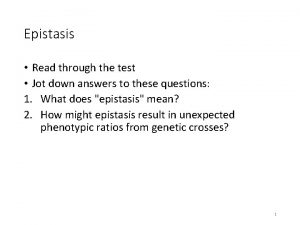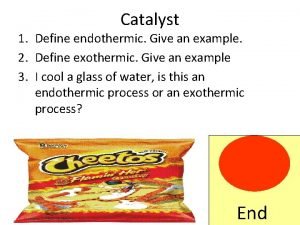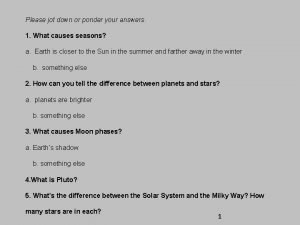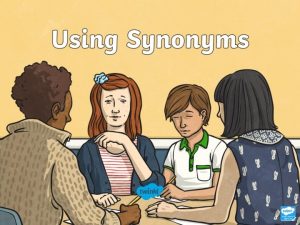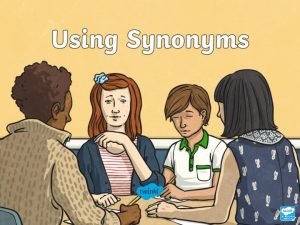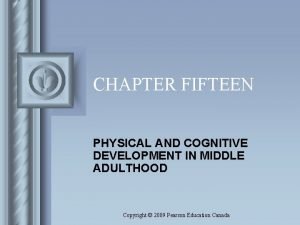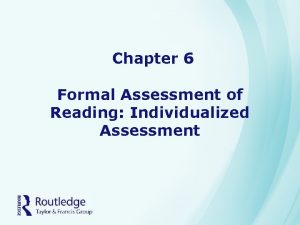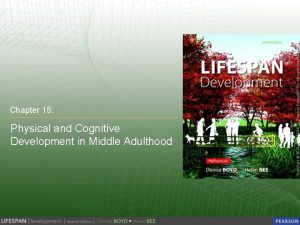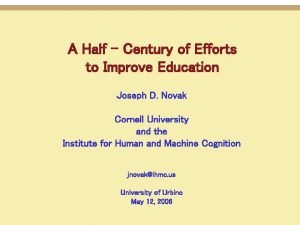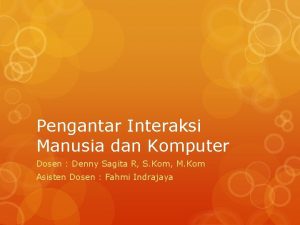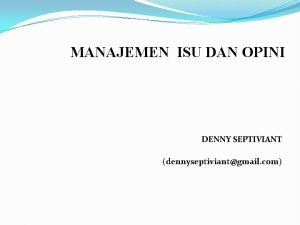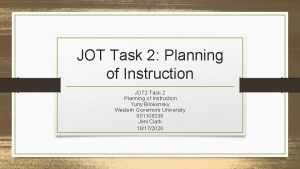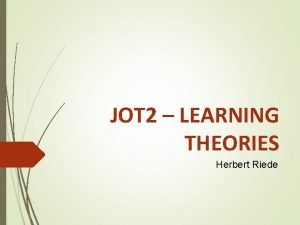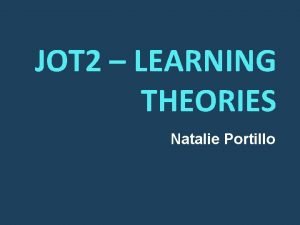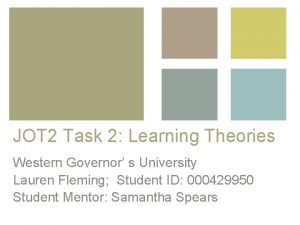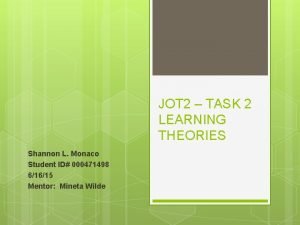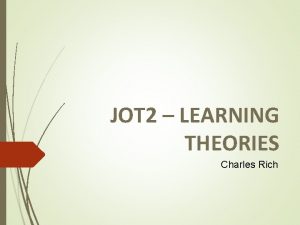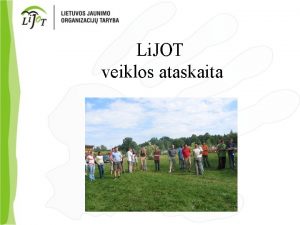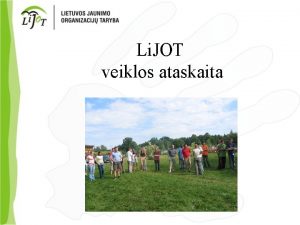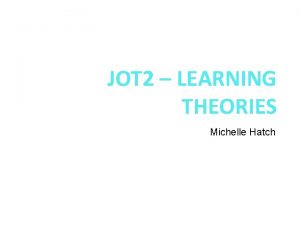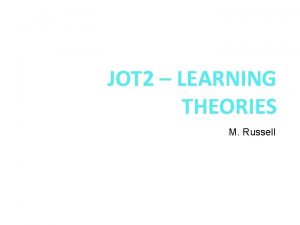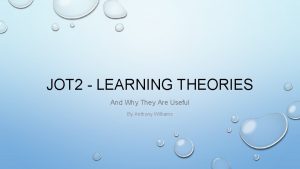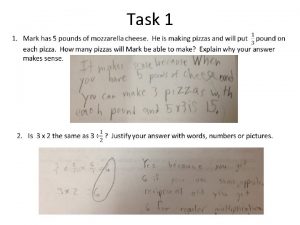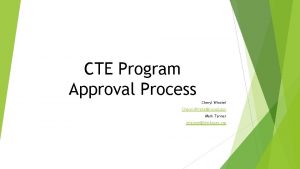JOT 2 LEARNING THEORIES Cheryl Denny Task A























- Slides: 23

JOT 2 – LEARNING THEORIES Cheryl Denny

Task A: Learning Theories & Learners • Behaviorism • Cognitivism • Constructivism

When Behaviorism is Beneficial for Learners �Teacher directed instruction �Basic skill acquistion �Automaticity of Math facts �Drill and practice �Classroom management �Positive reinforcement

When Cognitivism is Beneficial for Learners �Problem solving �Reasoning �Guided learning �Scaffolding �Collaborative groups �Modeling

When Constructivism is Beneficial for Learners �Advanced knowledge �Group projects �Hands on exploration �Class discussions �Experiments �Research projects

Task B: Learning Theory Used in Lesson Plan • Behaviorism Lesson Plan: “Seven Fat Cats” (Utah Lesson. Plans, 2003) • Teacher reads “Seven Fat Cats” • Students identify rhyming words •

Learning Theory – Lesson Plan �Lesson Plan for “Seven Fat Cats” (Utah Lesson. Plans, 2003) �Behaviorism • Teacher directed instruction • Teacher directed activities • Basic rhyming skills • Sound matching • Drill and practice

Task C: Adaptation of Lesson Plan • Cognitivism

Lesson Plan in Cognitivism �Add brain storming map �Students identify additional rhyming words �Follow up activity �Collaborative groups � Rhyming word fill in �Group discussion �Share collaborative group work

Task D: Lesson Plan Discussion • Behaviorism or Cognitivism

Behaviorism or Cognitivism for Lesson Plan �Cognitivism �Begin with original lesson �Expand lesson: include Cognitivism components �Encourages � Student involvement � Reasoning and thinking skills � Cooperative learning skills

Task E: Effective Instruction Through the Use of Design Theories • Wiggins Backward Design

Wiggins Backward Design �Identify desired results • Individualizes instruction for audience • Ensures instruction is viable �Acceptable evidence for assessment �Verifies learning occurs �Plans learning and instruction �Hones and drives writing of instruction

Task F: Wiggins & Gagne • Strengths and Limitations

Strengths of Wiggins Theory �Identifies desired results �Goals and objectives � Established � Ensures before writing instruction addresses goals and objectives �Identifies assessment process �Tailors and directs instruction �Planning instruction �Maximizes effective learning

Limitations of Wiggins �State standards �Big idea might not include all standards �Goals �Subject to vagueness �Student feedback �None required

Strengths of Gagne’s Events �Gaining attention �Engages brain activity �Objectives �Prepares learner �Prior learning �Builds on established brain pathways �Learner guidance and feedback �Encourages students

Limitations of Gagne’s Events �Instructional planning �No step included in model for planning �Nine step model �Lengthy �Laborious

Strengths of Teaching for Understanding �Generative topics �Correlates to students’ interests �Understanding goals �Can span over a school year �Performance of understanding �Students demonstrate new knowledge �Assessment is ongoing �Designer can begin in any order

Weaknesses of Teaching for Understanding �Design is not extraordinarily structured �Guidelines are vague �Learner audience �More suitable for upper grades

Task G: Most Suitable Design Process • Gagne’s Design

Gagne’s Design �Engages learners �Catches attention �Directs instruction by objectives �Prepares learners �Provides learner guidance �Necessary for young learners �Elicits practice �Crucial for acquisition of basic skills

References �Utah Lesson. Plans. (2003, August 8). Seven Fat Cats. Retrieved from http: //www. uen. org/Lessonplan/preview. cgi? LPi d =5640
 Cheryl denny
Cheryl denny Jot air balloon
Jot air balloon Naczelnik osp wymagania
Naczelnik osp wymagania Jot down questions
Jot down questions Define endothermic
Define endothermic Please jot down
Please jot down Write down synonym
Write down synonym Jot down synonym
Jot down synonym Concept learning task in machine learning
Concept learning task in machine learning Denny's model of physical and cognitive ageing
Denny's model of physical and cognitive ageing Nelson-denny standard score conversion
Nelson-denny standard score conversion Denny's model of physical and cognitive ageing
Denny's model of physical and cognitive ageing Denny schrock
Denny schrock Denny
Denny Ddboost oracle
Ddboost oracle Mitch denny
Mitch denny It support service denny
It support service denny Denný diagram zaťaženia
Denný diagram zaťaženia Denny sagita
Denny sagita Denny septiviant
Denny septiviant Hemodinamik
Hemodinamik Jiwab
Jiwab Ibm maximo roadmap
Ibm maximo roadmap Tiered task bias task
Tiered task bias task



